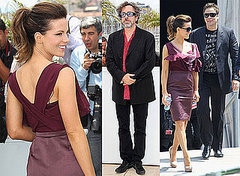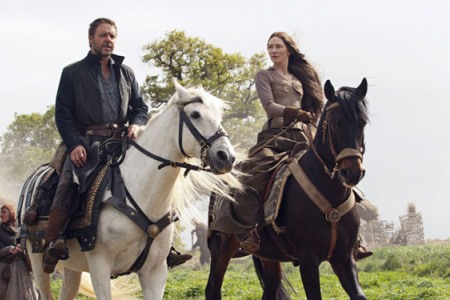Raised in Connecticut by wealthy, progressive parents, Hepburn turned to acting after graduation from Bryn Mawr College. After four years struggling in the theatre, favorable reviews of her work on Broadway brought her to the attention of Hollywood. Her feature debut, 1932's A Bill of Divorcement, was a success and turned her into an instant star. Within 18 months, she had won an Academy Award for Morning Glory. This initial success was followed by a series of commercial failures. Her brash personality and unconventional behavior, such as wearing trousers, began to turn audiences away, and in time she was labeled "box office poison". Hepburn masterminded her own comeback, buying herself out of her contract with RKO Radio Pictures and acquiring the film rights to The Philadelphia Story, which she sold on the condition that she be the star. The movie was a hit, and Hepburn's career was successfully revived.
Katharine Hepburn was born in Hartford, Connecticut, the daughter of suffragette Katharine Martha Houghton (1878–1951), and Thomas Norval Hepburn (1879–1962), a successful urologist and surgeon from Virginia. She was the second of six children. Hepburn idolized her parents, describing them as "perfect", and she often credited them with giving her the conditions that helped her succeed. Her mother was an active feminist who fought for birth control with the feminist pioneer Margaret Sanger and headed the Connecticut Woman Suffrage Association. Katharine Martha instilled in her young daughter the virtues of perseverance, independence and fortitude, teaching that women were equal to men, and as a child, Hepburn joined her mother on several "Votes For Women" demonstrations. Her father was pivotal in establishing the New England Social Hygiene Association, which aimed to educate the public about venereal disease. The Hepburn children were raised to exercise freedom of speech, and encouraged to think and debate on any topic they wished. Her parents were criticized by the community for their progressive views, which only stimulated Hepburn to fight against any barriers she encountered in life. Hepburn said she realized from a young age that she was the product of "two very remarkable parents", and felt she was lucky to have been "born out of love and to live in an atmosphere of warmth and interest." She was close with her siblings throughout her life, and said "I could not have been me without them."
The young Hepburn was a tomboy who liked to call herself Jimmy and often shaved her head, getting a thrill out of breaking into people's houses. Her father was a fine athlete, and taught and encouraged the children to swim, run, dive, ride, wrestle, golf and play tennis. Golf became a passion. Hepburn took daily lessons and became accomplished, reaching the semi-final of the Connecticut Young Women's Golf Championship. Hepburn loved swimming, and took daily dips in the cold waters that fronted her bay-front Connecticut home, generally believing (as she did throughout life) that "the bitterer the medicine, the better it was for you." She was a fan of movies from a young age, and went to see one every Saturday night. With her friends and siblings, she would put on plays and perform to her neighbors for 50 cents a ticket to raise money for the Navajo people.
On April 3, 1921, while visiting friends in Greenwich Village, Hepburn discovered the body of her older brother Tom, whom she adored, dead from an apparent suicide. He had tied a sheet around a beam and hanged himself. The Hepburn family denied it was suicide and maintained that Tom's death must have been an experiment that had gone wrong. The incident made the teenage Hepburn nervous and moody, suspicious of people, arrogant, disrespectful, and contemptuous of religion. She shied away from other children, dropped out of Oxford School, and began receiving private tutoring. For many years, she used Tom's birthday (November 8) as her own. It was not until her 1991 autobiography, Me: Stories of My Life, that Hepburn revealed her true birth date as May 12, 1907.
Hepburn gained a place at Bryn Mawr College, her mother's alma mater. It was the first time she had been in school in several years, and she was self-conscious and uncomfortable with her classmates. She would purposely wake up early to avoid them and never went to the dinner hall. By her second year she had formed a group of friends, and gained in confidence. She was once suspended for breaking curfew and smoking in her room. Hepburn was drawn to acting but roles in plays were conditional on good grades. After initial struggles with her studies, she achieved her goals. She began acting, appearing in The Truth about Blayds, The Cradle Song and the starring role in a big production of The Woman in the Moon. The positive response she received in this role cemented Hepburn's plans to pursue a theatrical career. She received a degree in history and philosophy in 1928, the same year she made her début on Broadway.
Hepburn left Bryn Mawr driven by ambition, determined to become an actress. A friend put her in touch with Edwin Knopf, who ran a successful theatre company in Baltimore. She went to see Knopf in person, taking her father's advice that "if you want to get something – don't write, don't telephone, be there yourself". Affected by her eagerness, Knopf cast Hepburn in The Czarina with Mary Boland. She received good notices for her small role, with the Printed Word describing her as "arresting." She was given a part in the following week's show, The Torch Bearers, but here Hepburn was less accomplished. She was criticized for her shrill voice, and so left Baltimore to study with an acclaimed voice tutor in New York City.
The Knopf Stock Company decided to produce The Big Pond in New York, with Kenneth MacKenna, and called for Hepburn to be the understudy to the leading lady. She had only been in the theatre for four weeks. The leading lady was fired and replaced with Hepburn. On opening night, Hepburn turned up late, mixed her lines, tripped over her feet, and spoke too high and fast to be comprehensible. She was promptly fired, and the original leading lady rehired. Undeterred, Hepburn joined forces with producer Arthur Hopkins, and accepted the role of a schoolgirl in These Days. It played at the Cort Theatre on Broadway, where reviews for the show were poor and it closed after only eight nights. Hopkins hired Hepburn as the understudy to Hope Williams in Philip Barry's play Holiday. After only two weeks, Hepburn quit to marry Ludlow Ogden Smith, a friend she had known since college. She planned to leave the theatre behind, but began to miss the work and quickly resumed her understudy role in Holiday. In 1929, Hepburn turned down a role with the Theatre Guild to play the lead in Death Takes a Holiday. She felt the role was perfect and could not resist it, but again she was fired for voice problems. Hepburn went back to the Guild and took an understudy role for minimum pay in A Month in the Country. In the spring of 1930, Hepburn joined the Alexander Kirkland & Strickland Stock Company in Stockbridge, Massachusetts. She left half-way through the summer season, and continued seeing a tutor to improve her voice. In early 1931, she was cast in Art and Mrs. Bottle. She was released from the role after the playwright took a dislike to her, saying "She looks a fright, her manner is objectionable, and she has no talent", but then rehired when no other actress could be found. It went on to be a small success. Hepburn appeared in a number of plays with a summer stock company in Ivoryton, Connecticut, including The Man Who Came Back and The Cat and the Canary and she proved to be a great hit. During the summer of 1931, Philip Barry asked her to appear in his new play, The Animal Kingdom, alongside Leslie Howard. They began rehearsals in November, Hepburn feeling sure this was the role to make her a star but Howard disliked the actress, and she was again fired. When asking Barry why this was, he responded, "Well, to be brutally frank, you weren't very good." This unsettled the self-assured Hepburn, but she continued to look for work. She took a small role in Alice Sit-by-the-Fire, with Laurette Taylor, but as rehearsals began she received an offer to read for a Broadway version of The Warrior's Husband and got the part.
Katharine Hepburn was born in Hartford, Connecticut, the daughter of suffragette Katharine Martha Houghton (1878–1951), and Thomas Norval Hepburn (1879–1962), a successful urologist and surgeon from Virginia. She was the second of six children. Hepburn idolized her parents, describing them as "perfect", and she often credited them with giving her the conditions that helped her succeed. Her mother was an active feminist who fought for birth control with the feminist pioneer Margaret Sanger and headed the Connecticut Woman Suffrage Association. Katharine Martha instilled in her young daughter the virtues of perseverance, independence and fortitude, teaching that women were equal to men, and as a child, Hepburn joined her mother on several "Votes For Women" demonstrations. Her father was pivotal in establishing the New England Social Hygiene Association, which aimed to educate the public about venereal disease. The Hepburn children were raised to exercise freedom of speech, and encouraged to think and debate on any topic they wished. Her parents were criticized by the community for their progressive views, which only stimulated Hepburn to fight against any barriers she encountered in life. Hepburn said she realized from a young age that she was the product of "two very remarkable parents", and felt she was lucky to have been "born out of love and to live in an atmosphere of warmth and interest." She was close with her siblings throughout her life, and said "I could not have been me without them."
The young Hepburn was a tomboy who liked to call herself Jimmy and often shaved her head, getting a thrill out of breaking into people's houses. Her father was a fine athlete, and taught and encouraged the children to swim, run, dive, ride, wrestle, golf and play tennis. Golf became a passion. Hepburn took daily lessons and became accomplished, reaching the semi-final of the Connecticut Young Women's Golf Championship. Hepburn loved swimming, and took daily dips in the cold waters that fronted her bay-front Connecticut home, generally believing (as she did throughout life) that "the bitterer the medicine, the better it was for you." She was a fan of movies from a young age, and went to see one every Saturday night. With her friends and siblings, she would put on plays and perform to her neighbors for 50 cents a ticket to raise money for the Navajo people.
 The Hobbit Movie – Cate |  Elizabeth Cate Blanchett | .jpg) Eva Longoria, Cate Blanchett |  Cate Blanchett, Russell Crowe |  May 12, 2010 The Cannes Film |
 Cate-Blanchett-cannes-2010 |  This movie is not only bad, |  Cate Blanchett Cannes 2010 |  Cate Blanchett Movie Stills |  Filmography Cate Blanchett |
Hepburn left Bryn Mawr driven by ambition, determined to become an actress. A friend put her in touch with Edwin Knopf, who ran a successful theatre company in Baltimore. She went to see Knopf in person, taking her father's advice that "if you want to get something – don't write, don't telephone, be there yourself". Affected by her eagerness, Knopf cast Hepburn in The Czarina with Mary Boland. She received good notices for her small role, with the Printed Word describing her as "arresting." She was given a part in the following week's show, The Torch Bearers, but here Hepburn was less accomplished. She was criticized for her shrill voice, and so left Baltimore to study with an acclaimed voice tutor in New York City.
 Poster de Cate Blanchett en . |  Cate Blanchett and Russell |  Cate Blanchett Cannes Honor |  Cate+Blanchett in Cannes Film |  Cate Blanchett 3. |
 Cate Blanchett Robin Hood |  Cate Blanchett\x26#39;s husband told |  carson kressley speedo 07 |  Carson Kressley is pictured at |  Carson Kressley |
No comments:
Post a Comment